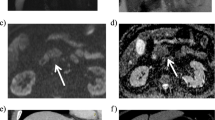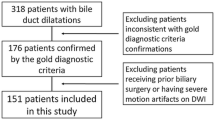Abstract
Objectives
To investigate the value of DWI for differentiating malignant from benign strictures in the periampullary region.
Methods
We retrospectively analysed data from 78 patients who had undergone magnetic resonance cholangiopanreatography (MRCP) and diffusion-weighted imaging (DWI), in whom biliary strictures in the periampullary region were suspected. Twenty-two malignant and 56 benign lesions were included. One radiologist compared the signal intensity of malignant and benign periampullary lesions on DWI using b = 500 and 800 s/mm2. The signal intensity of bile was also compared, and an optimal b value was determined for periampullary lesions. Two other radiologists reviewed MRCP alone and combined DWI and MRCP for the possibility of malignant periampullary lesions. Diagnostic accuracy was calculated for each reviewer by receiver operating characteristic (ROC) curve analysis.
Results
Malignant periampullary lesions more frequently appeared hyperintense than benign lesions on DWI using the two b values (P < 0.001). Bile more frequently appeared hyperintense on DWI using b = 500 s/mm2 (87.2 %) than b = 800 s/mm2 (24.4 %). Therefore, b = 800 s/mm2 was determined as the preferred sequence. Diagnostic accuracy for malignant periampullary lesions improved for both reviewers after adding DWI; from 0.714 to 0.924 (P = 0.006, for reviewer 1) and from 0.714 to 0.919 (P = 0.007, reviewer 2).
Conclusions
Combined DWI with MRCP can improve the diagnostic accuracy for differentiating malignant from benign strictures in the periampullary region.
Key Points
• Diffusion-weighted magnetic resonance imaging provides yet more information about hepatobiliary structures.
• Diffusion-weighted imaging (DWI) has now been applied to the biliary tree.
• Most periampullary carcinomas appear hyperintense on high b value DWI.
• DWI can help differentiate between malignant and benign periampullary lesions.






Similar content being viewed by others
References
Koh DM, Takahara T, Imai Y et al (2007) Practical aspects of assessing tumors using clinical diffusion-weighted imaging in the body. Magn Reson Med Sci 6:211–224
Koh DM, Collins DJ (2007) Diffusion-weighted MRI in the body: applications and challenges in oncology. AJR 188:1622–1635
Qayyum A (2009) Diffusion-weighted imaging in the abdomen and pelvis: concepts and applications. Radiographics 29:1797–1810
Sandrasegaran K, Akisik FM, Lin C et al (2009) Value of diffusion-weighted MRI for assessing liver fibrosis and cirrhosis. AJR 193:1556–1560
Taouli B, Vilgrain V, Dumont E et al (2003) Evaluation of liver diffusion isotropy and characterization of focal hepatic lesions with two single-shot echo-planar MR imaging sequences: prospective study in 66 patients. Radiology 226:71–78
Bruegel M, Holzapfel K, Gaa J et al (2008) Characterization of focal liver lesions by ADC measurements using a respiratory triggered diffusion-weighted single-shot echo-planar MR imaging technique. Eur Radiol 18:477–485
Parikh T, Drew SJ, Lee VS et al (2008) Focal liver lesion detection and characterization with diffusion-weighted MR imaging: comparison with standard breath-hold T2-weighted imaging. Radiology 246:812–822
Ichikawa T, Erturk SM, Motosugi U et al (2007) High-b value diffusion-weighted MRI for detecting pancreatic adenocarcinoma: preliminary results. AJR 188:409–414
Fattahi R, Balci NC, Perman WH et al (2009) Pancreatic diffusion-weighted imaging (DWI): comparison between mass-forming focal pancreatitis (FP), pancreatic cancer (PC), and normal pancreas. J Magn Reson Imaging 29:350–356
Takeuchi M, Matsuzaki K, Kubo H et al (2008) High-b-value diffusion-weighted magnetic resonance imaging of pancreatic cancer and mass-forming chronic pancreatitis: preliminary results. Acta Radiol 49:383–386
Zhang J, Tehrani YM, Wang L et al (2008) Renal masses: characterization with diffusion-weighted MR imaging—a preliminary experience. Radiology 247:458–464
Ichikawa T, Erturk SM, Motosugi U et al (2006) High-B-value diffusion-weighted MRI in colorectal cancer. AJR 187:181–184
Haider MA, van der Kwast TH, Tanguay J et al (2007) Combined T2-weighted and diffusion-weighted MRI for localization of prostate cancer. AJR 189:323–328
Naganawa S, Sato C, Kumada H et al (2005) Apparent diffusion coefficient in cervical cancer of the uterus: comparison with the normal uterine cervix. Eur Radiol 15:71–78
Tamai K, Koyama T, Saga T et al (2008) The utility of diffusion-weighted MR imaging for differentiating uterine sarcomas from benign leiomyomas. Eur Radiol 18:723–730
Cui XY, Chen HW (2010) Role of diffusion-weighted magnetic resonance imaging in the diagnosis of extrahepatic cholangiocarcinoma. World J Gastroenterol 16:3196–3201
Kim JH, Kim MJ, Chung JJ et al (2002) Differential diagnosis of periampullary carcinomas at MR imaging. Radiographics 22:1335–1352
Kim TU, Kim S, Lee JW et al (2008) Ampulla of Vater: comprehensive anatomy, MR imaging of pathologic conditions, and correlation with endoscopy. Eur J Radiol 66:48–64
Andersson M, Kostic S, Johansson M et al (2005) MRI combined with MR cholangiopancreatography versus helical CT in the evaluation of patients with suspected periampullary tumors: a prospective comparative study. Acta Radiol 46:16–27
Kim MJ, Mitchell DG, Ito K et al (2000) Biliary dilatation: differentiation of benign from malignant causes—value of adding conventional MR imaging to MR cholangiopancreatography. Radiology 214:173–181
Kandpal H, Sharma R, Madhusudhan KS et al (2009) Respiratory-triggered versus breath-hold diffusion-weighted MRI of liver lesions: comparison of image quality and apparent diffusion coefficient values. AJR 192:915–922
Park MS, Kim TK, Kim KW et al (2004) Differentiation of extrahepatic bile duct cholangiocarcinoma from benign stricture: findings at MRCP versus ERCP. Radiology 233:234–240
Chung YE, Kim MJ, Kim HM et al (2011) Differentiation of benign and malignant ampullary obstructions on MR imaging. Eur J Radiol 80:198–203
Takahara T, Imai Y, Yamashita T et al (2004) Diffusion weighted whole body imaging with background body signal suppression (DWIBS): technical improvement using free breathing, STIR and high resolution 3D display. Radiat Med 22:275–282
Low RN, Gurney J (2007) Diffusion-weighted MRI (DWI) in the oncology patient: value of breathhold DWI compared to unenhanced and gadolinium-enhanced MRI. J Magn Reson Imaging 25:848–858
Sugita R, Yamazaki T, Furuta A et al (2009) High b-value diffusion-weighted MRI for detecting gallbladder carcinoma: preliminary study and results. Eur Radiol 19:1794–1798
Kim S, Lee NK, Lee JW et al (2007) CT evaluation of the bulging papilla with endoscopic correlation. Radiographics 27:1023–1038
Feuerlein S, Pauls S, Juchems MS et al (2009) Pitfalls in abdominal diffusion-weighted imaging: how predictive is restricted water diffusion for malignancy. AJR 193:1070–1076
Yeh BM, Liu PS, Soto JA et al (2009) MR imaging and CT of the biliary tract. Radiographics 29:1669–1688
Author information
Authors and Affiliations
Corresponding author
Rights and permissions
About this article
Cite this article
Lee, N.K., Kim, S., Seo, H.I. et al. Diffusion-weighted MR imaging for the differentiation of malignant from benign strictures in the periampullary region. Eur Radiol 23, 1288–1296 (2013). https://doi.org/10.1007/s00330-012-2725-6
Received:
Revised:
Accepted:
Published:
Issue Date:
DOI: https://doi.org/10.1007/s00330-012-2725-6




